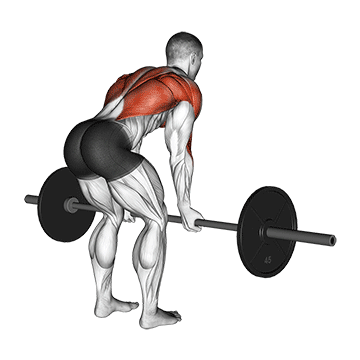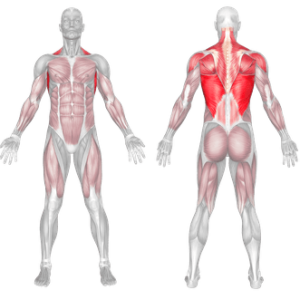Reverse Grip Barbell Row
The Reverse Grip Barbell Row is a variation of the traditional Barbell Bent Over Row, where you change the grip on the barbell to an underhand grip (palms facing upward). This grip variation shifts the emphasis of the exercise, placing more emphasis on the biceps and the lower lats, while still engaging the upper back muscles.
How to do:

- Setup: Stand with your feet shoulder-width apart, toes pointing forward, and the barbell in front of you on the floor. For the Reverse Grip Barbell Row, take an underhand grip on the barbell (palms facing up), with your hands positioned slightly wider than shoulder-width apart.
- Bend at the Hips: Hinge at your hips while keeping your back straight. Lower your torso until it is almost parallel to the floor. Keep your knees slightly bent throughout the movement.
- Grasp the Barbell: Reach down and grip the barbell with the underhand grip. Your arms should be fully extended, and your grip should be firm.
- Starting Position: Your back should be flat, chest out, and shoulder blades pulled back and down. This is the starting position.
- The Row: Pull the barbell towards your upper abdomen or lower chest while keeping your elbows close to your body. Focus on squeezing your shoulder blades together at the top of the movement to engage your back muscles fully.
- Lower the Barbell: Slowly lower the barbell back down to the starting position while maintaining control. Do not allow the weight to pull you forward; instead, control the descent.
- Repeat: Perform the desired number of repetitions.
Tips for Proper Form:
- Maintain a flat back and avoid rounding your shoulders during the exercise.
- Keep your head in a neutral position, looking slightly forward, to maintain proper spinal alignment.
- Focus on using your back muscles to pull the weight, rather than relying solely on your biceps.
- Engage your core throughout the movement for stability and to protect your lower back.
Reverse Grip Barbell Row – Benefits
Lower Lats Activation: The Reverse Grip Barbell Row targets the lower portion of the latissimus dorsi (lats) more than the traditional overhand grip. This can lead to improved development of the lower back and give your lats a fuller appearance.
Upper Back Strengthening: Like the standard Barbell Bent Over Row, the reverse grip variation still engages the upper back muscles, including the rhomboids and traps. This helps to enhance overall upper back strength and stability.
Compound Exercise Benefits: As a compound movement, the Reverse Grip Barbell Row involves multiple muscle groups working together. This can lead to greater overall muscle activation, higher caloric expenditure, and improved functional strength.
Grip Strength: Holding the barbell with an underhand grip challenges your forearm and grip strength. Over time, this can lead to improved grip strength, which is beneficial for various exercises and everyday tasks that require a strong grip.
Muscle Balance: By incorporating both overhand and underhand grip variations in your workout routine, you can achieve better muscle balance in the back and arms. This can help prevent muscle imbalances and reduce the risk of injury.
Functional Strength: The rowing motion in the Reverse Grip Barbell Row is akin to movements involved in daily activities like lifting objects from the ground or pulling doors. By training this movement pattern, you can improve functional strength for daily tasks.
Postural Improvement: Strengthening the upper back muscles and lats can lead to improved posture and reduced risk of postural issues like rounded shoulders.
The Reverse Grip Barbell Row provides similar benefits to the traditional Barbell Bent Over Row, with some additional focus on the biceps and lower lats due to the underhand grip. This variation can be a valuable addition to your workout routine to target the back muscles from a different angle and potentially enhance overall upper body development.
Reverse Grip Barbell Row – Muscles Worked

